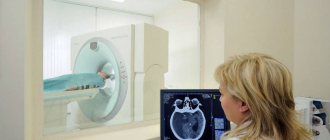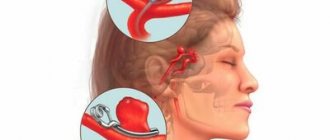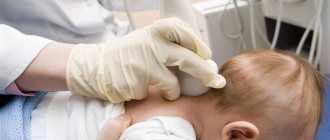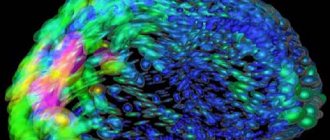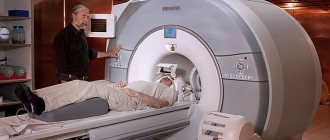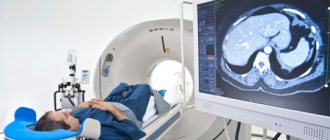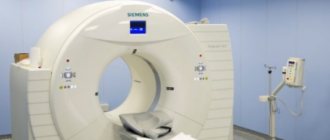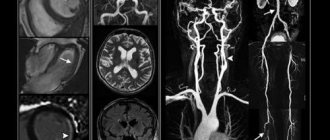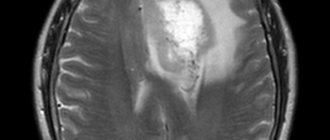Brain concussion
Vomit
2692 05 August
IMPORTANT!
The information in this section cannot be used for self-diagnosis and self-treatment.
In case of pain or other exacerbation of the disease, diagnostic tests should be prescribed only by the attending physician. To make a diagnosis and properly prescribe treatment, you should contact your doctor. Concussion: causes, symptoms, diagnosis and treatment methods.
Definition
A concussion is a functionally reversible form of closed craniocerebral injury without organic damage to the brain, resulting from a bruise, blow, and in rare cases as a result of a sudden movement of the head.
Causes of concussion
A concussion can result from a traffic accident, a fall, domestic, sports and work-related injuries, as well as injuries received as a result of street fights and collisions during public events, or exposure to a blast wave. Even a seemingly minor head injury can lead to a concussion. Thus, the fact of an injury may already indicate a possible concussion.
The mechanism of concussion is not precisely known. Most likely, the injury causes some problems with the functioning of the brain's nerve cells (neurons). It is assumed that there is a functional disconnection between the brain stem and hemispheres of the brain. It is believed that due to concussion, a temporary disruption of interneuronal connections occurs. A slight displacement of the layers of brain tissue may appear, their nutrition may deteriorate and the connection between some brain centers may be disrupted, which contributes to the development of functional disorders. In this case, macroscopic and histological changes in brain tissue are not detected.
Among all brain injuries, concussion ranks first in frequency. In most patients, recovery occurs within 1-2 weeks.
If the patient's condition continues to deteriorate over time, and more severe forms of traumatic brain injury have been ruled out, then it is necessary to look for other causes of the existing symptoms - psychological problems, mental illness, side effects of medications or other concomitant diseases.
Classification of the disease
According to the International Classification of Diseases (ICD-10), concussion is coded S06.0. This nosology is one of the clinical forms of traumatic brain injury.
Depending on the severity of the patient’s condition and clinical symptoms, three degrees of concussion are distinguished.
Mild concussion. The victim does not have any impairment of consciousness, but disorientation, headache, dizziness, and nausea may occur during the first 20 minutes after the injury. Then general health returns to normal. A short-term increase in body temperature (37.1-38°C) is possible.
Moderate concussion. Although the victim does not lose consciousness, pathological symptoms such as headache, nausea, dizziness, and disorientation may be observed. All of them last more than twenty minutes. Short-term memory loss (amnesia) may occur, most often retrograde amnesia with the loss of several minutes of memories preceding the injury.
Severe concussion. It is necessarily accompanied by loss of consciousness for a short period of time, usually from several minutes to several hours. The victim does not remember what happened - retrograde amnesia develops. Pathological symptoms bother a person for 1-2 weeks after the injury (headache, dizziness, nausea, fatigue, disorientation, loss of appetite and sleep).
Symptoms of a concussion
Physical (somatic) symptoms:
- dizziness at rest, which intensifies when changing body position, turning or tilting the head - this is explained by impaired blood circulation in the vestibular apparatus;
- throbbing headache;
- nausea;
- one-time vomiting;
- rapid breathing, tachycardia;
- blurred vision or double vision;
- flashing of flies or stars before the eyes;
- imbalance;
- increased sensitivity to light or noise;
- ringing, noise in the ears.
Behavioral, emotional symptoms:
- drowsiness;
- increased fatigue or general weakness;
- irritability;
- depression;
- anxiety;
- excessive hours of sleep;
- difficulty falling asleep.
Cognitive symptoms:
- lethargy and impaired coordination of movements;
- short-term confusion;
- slow, incoherent speech;
- difficulty concentrating;
- difficulties remembering.
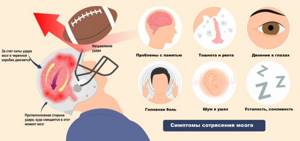
The diagnosis of a concussion is established on the basis of anamnesis, examination and the exclusion of more severe traumatic brain injury.
The doctor examines the patient's entire body for abrasions, bruises, joint deformities, changes in the shape of the chest and abdomen, and bleeding.
In the first hours after a concussion, the victim’s pupils are dilated or constricted - a traumatic brain injury of any severity leads to disruption of the nerve pathways responsible for the functioning of the eyes. The reaction of the pupils to light is normal. The victim complains of pain when moving the eyes to the sides; fine horizontal nystagmus (involuntary trembling movements of the eyeballs) is observed if the eyes are moved to the most extreme positions. Slight asymmetry of tendon reflexes and unsteadiness in the Romberg position (legs together, straight arms extended forward to a horizontal level, eyes closed) may be detected. The level of consciousness is assessed using the Glasgow Coma Scale and is 14-15 points.
The list of laboratory tests includes:
- general blood analysis;
Symptoms of a concussion
Symptoms of a concussion (one or more of the following):
- Headache;
- agitation or drowsiness;
- Poor tolerance to bright light and loud sounds;
- Confusion;
- Dizziness and coordination problems;
- Loss of consciousness - from a few seconds to hours;
- Memory impairment (events immediately before the injury and/or immediately after the injury are usually lost from memory);
- Slurred speech;
- Noise in the ears, double vision;
- Convulsions;
- Different pupil sizes
- Disorientation in time, space, self, etc.
A poorly treated concussion is dangerous, first of all, because of its long-term consequences , which occur 6-18 months after the traumatic brain injury. If you doubt the presence/absence of a concussion, it is better to play it safe and clarify the situation with the help of a neurologist. In doubtful cases, we will clarify the patient’s condition using magnetic resonance imaging , brain evoked potential studies and other highly sensitive diagnostic methods.
Symptoms of a concussion in an adult
Numerous signs of the disease in adults do not make it possible to make a diagnosis during an external examination or study of symptoms. Boxers suffer from frequent concussions. Frequent blows to the head are characterized by the gradual development of encephalopathy.
Symptoms of pathology in an adult:
- Loss of balance;
- Slight lag of one leg when walking;
- Slowing down movements;
- Impoverishment of speech;
- Slowing down of mental reaction;
- Trembling of the head and limbs.
The described signs appear with a moderate or severe concussion. Manifestations of a mild form in an adult:
- The appearance of mental disorders after drinking alcohol, infectious diseases;
- Exacerbation of vasomotor reactions with headache, hyperemia of the skin during physical activities (bending, running, lifting weights);
- Sudden irritability, tendency to muscle cramps;
- Formation of paranoid personality traits (neuroses, fears, anxieties, emotional instability).
A common presentation of a moderate concussion is post-concussion syndrome, which occurs several weeks or months after the injury to the skull. Psychotherapeutic treatment of the disease is ineffective.
Concussion grades
In children, signs of a concussion are considered a variant of a closed craniocerebral injury with signs of compression of intracerebral formations and damage to the cerebellum. Experts divide the symptoms of pathology into three degrees:
- Mild – manifestations persist only 15 minutes after injury, there is no disturbance of consciousness;
- Moderate (II degree) – symptoms last for several hours, there is no pathology of the conscious sphere;
- Severe (III) – the child loses consciousness immediately or some time after the blow.
In the mild stage, there is no damage to the skull bones, and minor functional disorders occur.
Main symptoms of a concussion
Determining the diagnosis using clinical methods is based on identifying a number of neurological disorders:
- Dizziness;
- Pain when moving the eyes;
- Gag reflex, nausea;
- Weakness and fever;
- Breathing disorders;
- Insomnia.
Severe skull injuries are accompanied by damage to intracerebral vessels, swelling of brain tissue, and concomitant infectious and inflammatory changes. Severe degrees are accompanied by contusion and bruise of brain tissue. A feature of the clinical symptoms of severe disorders is bleeding from the nose, mouth, and ears.
The appearance of contusion is characterized by epileptic seizures and paralysis of the limbs. With diffuse hemorrhages, loss of intelligence and memory occurs, and neurological disorders develop.
Intracerebral concussion is the mildest of all types of closed head injury. It is necessary to take into account long-term symptoms of the disease that occur several months after the initial injury. To exclude negative consequences, additional high-precision studies are required - computed tomography and magnetic resonance imaging (CT and MRI).
Do I need to seek medical help?
You should contact your doctor (pediatrician/neurologist) if your child has any of the above symptoms of mild head injury and you are concerned about them. Otherwise, continue to monitor your child at home for any of the warning signs and symptoms described below.
Threatening symptoms requiring emergency care and examination by a doctor at the nearest hospital:
- vomiting more than once
- bleeding or any discharge from the ear or nose
- seizures/convulsions/twitching
- inability to recognize people or places
- severe drowsiness
- loss of consciousness
- incessant crying
- one pupil is larger than the other
- blurred vision or double vision
- poor coordination or clumsiness
- any new weakness in an arm or leg, or any existing weakness that gets worse or does not improve
- difficulty swallowing or coughing while eating or drinking
- noise sensitivity
- slurred or unclear speech
- unusual or confusing behavior
- severe or persistent headache that does not respond to paracetamol
- the injury was caused by high speed and/or altitude
Symptoms of a concussion
Check for symptoms immediately after injury and for several (2-3 days).
All concussion symptoms can be divided into 5 subtypes (Lumba-Brown et al. Neurosurgery 2020):
- Headache/migraine (the most common symptom in children and adolescents, often with aura, nausea/vomiting, sensitivity to light/sound/smell; if children have previously suffered from headaches, then after a concussion the frequency and severity of pain increases).
- Oculomotor disorders (dysfunction of the visual system - problems with focusing, photophobia, double vision, eye fatigue, etc.).
- Vestibular disorders (impaired movement and orientation of the body in space and time; dizziness; nausea/vomiting).
- Emotional disturbances (mood changes - restlessness, anxiety, depression, sadness, fatigue, sometimes anger and irritability).
- Cognitive impairment (impaired concentration, memory, reaction speed, decreased mental performance).
Sleep disturbance is also a common condition associated with concussion.
Common signs and symptoms of a concussion may include:
- Headache or feeling of pressure in the head
- Nausea or vomiting
- Balance problems or dizziness
- Double or blurry vision
- Sensitivity to light or noise
- Feeling tired, lethargic, drowsy, or dazed
- Difficulty with attention
- Memory problems
- Confusion
- Slowness in understanding and reacting to others
- Sleep problems
- Mood swings and irritability
- Changes in behavior
- Personality changes
Children who have suffered a head injury may develop symptoms at different times. Some of the symptoms may appear minutes or hours after the initial injury, while others may take days or weeks to appear.
